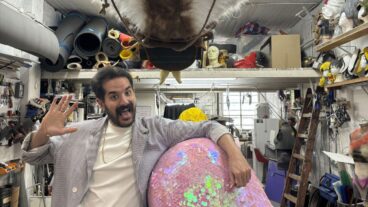Architect Daniel Libeskind poses at the site of World Trade Center in New York after his design was selected by the Lower Manhattan Redevelopment Corporation as the one that will be erected on the site where the World Trade Center once stood. (AP)Israeli-American architect Daniel Libeskind has been chosen to design the new New York complex which will stand on the site of the World Trade Center.
Following months of debate and an architectural competition, New York officials appointed Libeskind to design the world’s tallest building at the WTC site while retaining a memorial to the more than 3,000 victims of September 11, 2001.
While Libeskind holds joint Israeli-U.S. citizenship and currently lives in Berlin, he doesn’t discount the chapter of his life spent in Israel nor his Jewish roots. “I am still an Israeli,” he told The Jerusalem Post in an interview last year.
He recently noted in a German newspaper that parallels to his sombre-yet-soaring plan for rebuilding Ground Zero in Manhattan can be found in Jerusalem’s Temple Mount.
Keeping in mind the deep sensitivities of victims and their families, Libeskind says in the interview that Ground Zero must be viewed as hallowed land which is also part of ongoing history – like the Temple Mount, the site in Jerusalem sacred to Moslems as the Dome of the Rock.
“There are precedents,” he said in the interview, “the Temple Mount for example. It is one of the most positive places in the world and yet a site of utter destruction. We must accept that September 11 is irreversible. We can never return to the time before then. The question now is: How can we transform this insight into something positive?”
The life of 55-year-old Libeskind encompasses the full Jewish experience of the 20th century. He was born in Poland in 1946 to Holocaust survivors who met in a displaced persons camp, and then moved to Israel in 1957. The family later relocated to New York to join his father’s sister: the only surviving sibling of his father’s ten brothers and sisters. He and his wife of 34 years, Nina, met at a summer camp for the children of Holocaust survivors in New York, where Yiddish was the common language. The couple have three children.
Libeskind has said that his view of lower Manhattan and the New York skyline will always be colored by his first glimpse of the Statue of Liberty through early morning mist from the ship that brought his family to America when he was 13. The family settled in the Bronx and his father worked in a small Hasidic print shop near Wall Street.
“I have never forgotten that sight or what it stands for. This is what this project is all about,” he has said.
Asked once if he considers himself a “Jewish architect,” Libeskind responded, “There is a Jewish dimension to my life in general. It’s in my life; how can I do something foreign to that?” His Jewish background, he said, is such that “you could put me at a table with Hassdim on one side and virulent atheists on the other. And I could speak to all of them.”
A keyboard prodigy, Libeskind was a virtuoso pianist. In 1959, at age 13, a jury awarded him the America-Israeli Cultural Foundation Prize. By 1960 he was performing at Carnegie Hall. He graduated from the elite Bronx High School of Science, and then, when his interest shifted to architecture, he gave up performing. He earned his degree in architecture in 1970 at the Cooper Union for the Advancement of Science and Art, about a mile from where the World Trade Center was being built at the time.
Since then, he has lived and worked in Michigan, Milan, and California, finally settling down and establishing his architectural firm in Berlin. A small but striking man with a shock of gray hair and rectangular glasses, Libeskind is considered a compelling speaker, and a passionate and optimistic person.
His prominence as an architect has come relatively late in life. Libeskind was viewed purely as a conceptual architect and an academic, serving as the head of the architecture department at Cranbrook Academy of Arts in Michigan from 1978 to 1985. All of this changed after the first building he fully designed and built, the Jewish Museum in Berlin in 1999, was unveiled met with international praise. In 2001, his work on the museum made him the first architect to be awarded the Hiroshima Art Prize, given to an artist whose work promotes understanding and peace.
In recent years, he and his firm have been tremendously busy. Libeskind’s current project list includes a Jewish museum in San Francisco, a convention center at Bar-Ilan University, extensions to museums in Denver and Toronto, the interior of Copenhagen’s Jewish museum, the largest shopping center in Europe, and an extension to Toronto’s Royal Ontario Museum.
But the building on the World Trade Center site will undoubtedly be the most important project of his career. His plan contains a “Matrix of Heroes” that will radiate outward from a central plaza. Its lines would trace the routes taken by firemen, policemen and rescue workers as they entered the site on Sept. 11. But they will also extend upward and out toward the horizon to include all citizens in “the matrix of life.”
Access to the original buildings’ “footprint” 70 feet below ground is an integral part of Libeskind’s design for the site, as well as a “wedge of light” through which sunshine will stream on September 11. The open and lighted underground memorial will provide an intimate place where people can meditate while remembering the dead.












